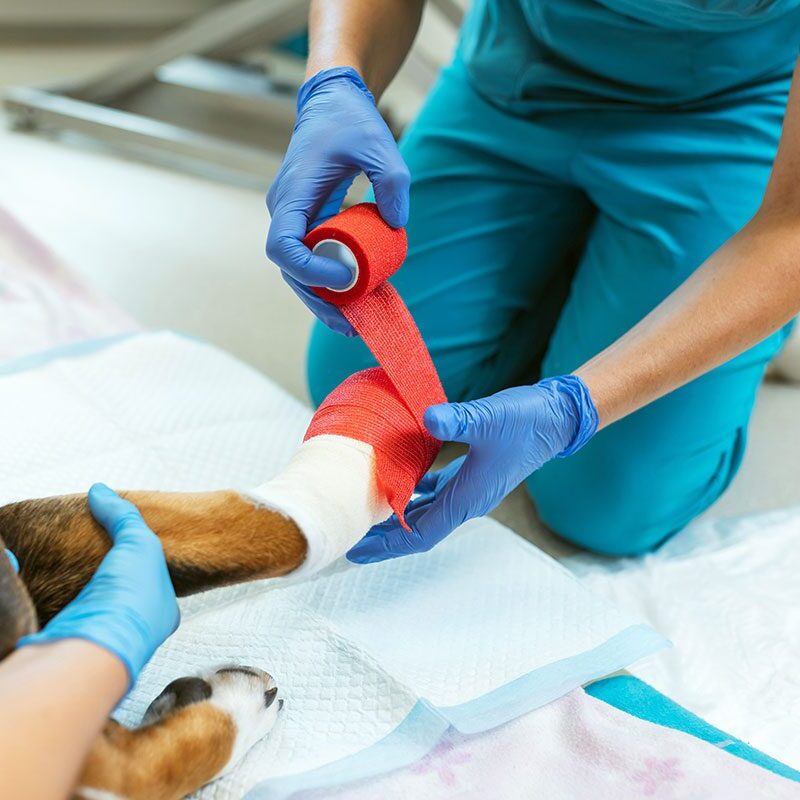
A bone fracture, or broken bone, in a dog is a serious injury that can result from trauma, falls, or, in some cases, underlying medical conditions that weaken the bone. Fractures are painful and require immediate veterinary attention. Prompt and proper treatment is essential to support healing and prevent complications.
Recognizing the Signs of a Fracture
Fractures are almost always painful, and most dogs will show clear signs of distress, such as:
- Lameness or Limping: Difficulty or refusal to bear weight on the affected limb.
- Pain: Sensitivity to touch or pain when the limb is moved.
- Swelling, Bruising, or Bleeding: Particularly in open fractures where the bone pierces the skin.
- Deformity: The limb may look bent, twisted, or misshapen.
- Abnormal Mobility: The limb may move unnaturally or feel unstable.
- Vocalization: Crying, whimpering, or barking in response to pain.
- Behavioral Changes: A normally friendly dog may act defensively or aggressively when the area is touched.
Types of Fractures
Fractures vary in severity and type:
- Closed Fracture: Bone is broken, but skin remains intact.
- Open Fracture: Bone breaks through the skin or is exposed via an open wound, increasing infection risk.
- Incomplete Fracture: Partial break where only one side of the bone is damaged.
- Complete Fracture: Bone is fully broken into two or more pieces.
- Comminuted Fracture: Bone shatters into three or more pieces.
- Salter-Harris Fracture: Involves the growth plate in young dogs.
- Pathological Fracture: Caused by a disease (e.g., bone cancer) that weakens the bone.
What to Do If You Suspect a Fracture
- Muzzle Your Dog: Even gentle dogs may bite when in severe pain.
- Do Not Attempt to Set the Bone: This could cause further injury.
- Minimize Movement: Move your dog to a quiet, secure area and limit activity. Use a crate or blanket stretcher if necessary.
- Cover Open Fractures: Use a clean cloth or sterile dressing to reduce contamination.
- Call Your Veterinarian Immediately: Contact your vet or an emergency clinic for guidance and to let them know you’re on your way.
Your veterinarian will assess your dog, look for other injuries, and take X-rays to determine the fracture’s type, location, and severity.
Treatment Options
The goal of treatment is to realign the bone and keep it stable while it heals. The choice of treatment depends on fracture type, location, severity, age of the dog, and overall health.
External Stabilization (Splints and Casts)
- Best for simple, closed fractures in certain lower leg locations.
- Immobilizes the bone with a cast or splint.
- Requires regular bandage changes and monitoring for swelling, sores, or infection.
- Lower initial cost than surgery but needs frequent rechecks.
- Healing usually takes 2–3 months, with confinement and an Elizabethan collar.
Internal Stabilization (Surgical Repair)
- Often preferred for complex, open, or joint-involving fractures.
- Realigns the bone surgically and secures it with plates, screws, pins, wires, or rods.
- Offers excellent stability and can promote faster healing.
- Techniques include plate and screw fixation or interlocking intramedullary nails.
- Some minimally invasive methods preserve blood supply and reduce pain.
- Implants may or may not be removed after healing.
External Skeletal Fixation
- Uses pins inserted through the skin into the bone, connected to an external frame.
- Allows access to treat soft tissue wounds.
- Often used for complex fractures or angular limb deformities.
- Requires diligent post-operative care.
Amputation
Considered when the limb cannot be repaired or if complications (e.g., severe infection) threaten the dog’s well-being.
Recovery and Home Care
- Strict Rest: Confinement for 8–12 weeks or as directed.
- Medication: Administer pain relief, anti-inflammatories, and antibiotics if prescribed.
- Incision/Cast Care: Keep surgical sites or casts clean and dry, and follow your vet’s bandage change instructions.
- Elizabethan Collar: Prevents licking or chewing at the injury.
- Rehabilitation: Physical therapy, laser therapy, and hydrotherapy can help restore mobility.
- Follow-Up Appointments: Regular rechecks and X-rays to monitor healing.
Potential Complications
- Infection (especially with open fractures)
- Delayed or incomplete healing
- Malunion (bone heals incorrectly)
- Implant issues (loosening or failure)
- Growth plate damage in young dogs
- Osteoarthritis in affected joints
Long-Term Outlook & Prevention
With proper treatment and care, most fractures heal well. Puppies may heal in 1–2 months, while older dogs often need 2–4 months or more. Most return to normal activity after recovery.
Prevention Tips:
- Use a leash in uncontrolled areas to prevent accidents.
- Prevent falls from heights.
- Supervise play to avoid rough collisions.
- Maintain a healthy weight and balanced diet for strong bones.
- Treat underlying medical conditions that may weaken bones.
If you suspect a fracture, seek veterinary care immediately—early intervention gives the best chance for full recovery.
Recent Posts
About Us
Knox Veterinary Surgery provides advanced orthopedic, soft tissue, and exotic pet surgeries right in your practice, making care easier for you and your clients. Serving Tennessee and surrounding states, we deliver skilled, compassionate care in a familiar setting.
